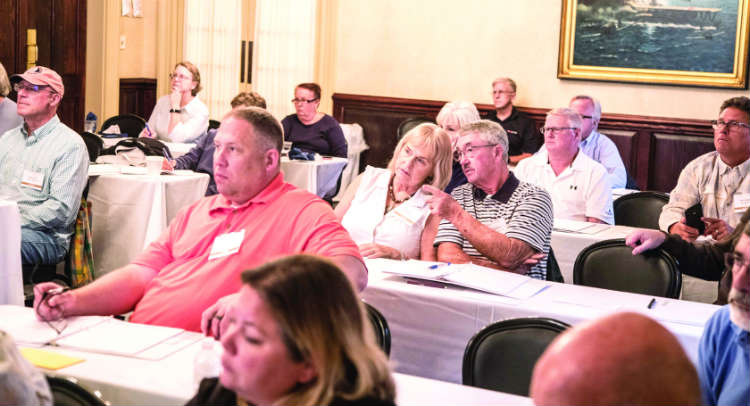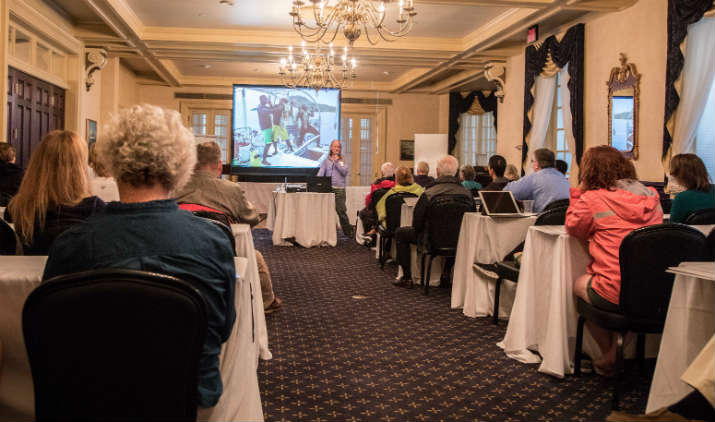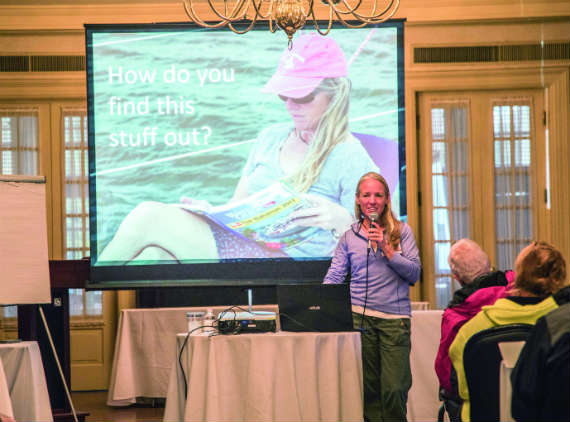Classroom Experiences Can Benefit Your Cruising Knowledge
When Don Laut was caught in thick fog near Tiverton, RI, this summer, his wife panicked, but Laut kept his cool. “I had taken a class at Cruisers University on electronic navigation, and the simulation we used was ideal prep for navigating fog in our sailboat. I was faced with the same situation and knew exactly how to handle it.”
Laut is a serious student. Twice a year for the past three years, he has returned to Annapolis during the sail and power boat shows—in the fall and again in the spring during Annapolis Boat Shows—to take as many Cruisers U classes as he can.

What’s left for a seasoned boater to learn? “You’d be surprised,” says Laut, an electrical contractor from Gaithersburg, MD, who has been boating on the Chesapeake since he was a kid. “Maritime best practices are quite different from those in a house. I have a French boat, and the electrical set-up is done in an odd way that I am not used to; my electrical experience on boats is limited to fire alarms and some emergency lighting systems. What are the risks? How can I avoid them? I’d rather learn from a highly experienced instructor who has logged years as a sailor than have to ‘audit’ the real experience at sea.”
Laut left powerboating behind several years ago to focus on sailing “in search of serenity.” He and his wife, Carol, cruise as much as they can on their 48-foot Fountaine Pajot Makarios, which means ‘blessed,’ up and down the ICW and throughout the Caribbean and New England. Once they are both retired, Laut plans to “live the dream” and sail for six months at a time to destinations such as the Panama Canal, Mediterranean, and Fiji.
In the meantime, Laut has logged more than 250 hours at Cruiser U, including the popular two-day master program in diesel mechanics. Cruiser U offers a two-day master program in women’s cruising, and a range of electives, such as night cruising, short- and single-handed sailing, storm tactics and prep, navigation, systems maintenance, and managing relationships on board.
“My goal is to be as resourceful and prepared as possible,” says Laut. He is not alone. He joined about 180 boaters, mostly sailors, who attended Cruisers University at the Annapolis Boat Shows this fall; another 180 will typically attend in the spring.

Many of Cruisers U’s alumni return for new classes—this year’s included Offshore Yacht Rigging, The Paperwork of Cruising, Planning a Voyage, Creating the Unstoppable Boat, Dollars and Sense, Useful Knots for Boaters, Writing, Blogging, and Video, and a refresher on everything from electrical systems and communications to marine weather forecasting.
“These are budget sailors and high-end sailors. They are evenly split, men and women. They come back year after year to fill the gaps in their knowledge and experience,” says Nancy Grisham, educational event coordinator for the Annapolis Boat Shows. “Some are couples who are getting ready to ‘live the dream’—to get on that boat and just go. Many of our alumni are in the dream stage. They might have a year, a year and a half; then they are going to do it.”
With all the regional training options available around the U.S., why attend Cruisers U? “You cannot get this kind of instruction anywhere else,” says Laut. “People come from all over the country. The master class on diesel mechanics was one of the first ones that I took. It is a necessity to be able to deal with diesel engine troubles and very hard to find this kind of class.”
Grisham agrees, “It sells out every year. This is taught in very few places. No one can help you out there if the engine has a problem. It’s not rocket science, but it is essential”

The experience and skill of the instructors is another draw. “They each bring their own knowledge; this is so incredibly valuable… The instructors make time for you—one-on-one.”
Laut had lunch with Behan Gifford, who has logged more than seven years at sea, sailing around the world with her family, and was surprised at her take on communications “She said that if she was starting out today, she would spend money on Iridium Go! rather than the SSD. I have a single SSD, which until recently has been the preferred device for long passages.”
Laut also discovered that there is more to know about weather and safety. “I thought I had taken everything related to heavy weather tactics, but some of the instructors have different strategies.” Laut talked in depth with instructor Lin Pardey (coauthor with her her husband of “Storm Tactics”). “When dealing with heavy storms, author and sailor John Kretschmer prefers to run with the wind, as opposed to heaving to with a sea anchor off the bow. Lin Pardey was able to offer me tips for using an anchor and sea line off the bow of a catamaran in heavy weather, even though she has a monohull.”
When it comes to safety, Laut says his wife is a nurse, but he wonders, “What if something happens to her? Am I prepared? I was surprised to learn from instructor Behan Gifford that there are hospitals in remote places, like Fiji and the Maldives, and they are okay.”
Laut says it was “illuminating” to learn how much time Behan spent on land, in safety, when sailing around the world. “She and her husband logged 3400 days living on their boat and of those, 246 days spent on night passages, and of those, only three or four were passages of seven nights or longer—and they had gone all the way around the world! You think you will be at sea all the time, but there is plenty of time spent on land.”
Laut admits that there are some things the classroom did not prepare him for. He had a close call on the Chesapeake after he hired, but didn’t fully vet, a crew member. “I thought I had the right person at the helm on watch; the chart plotter on the helm was not working as we sailed the Chesapeake. I was below at the nav station and quickly realized looking at the AIS that we were about 45 seconds away from a collision with a tugboat pushing a massive barge.”
Laut took the helm and avoided the collision. “I learned to be skeptical of people’s sailing resumes. Sure, this fellow had crossed the Atlantic—but it was on the Queen Elizabeth 2.”
Learn more about Cruisers University here.
~By Patricia Dempsey




